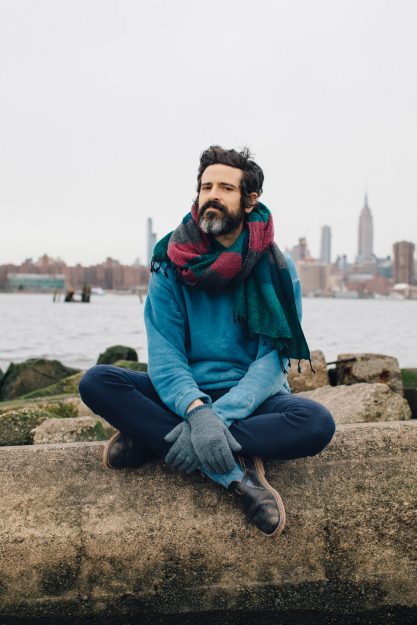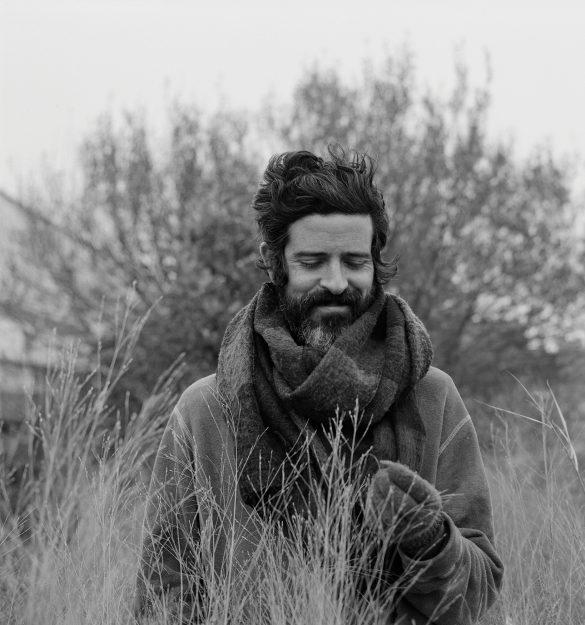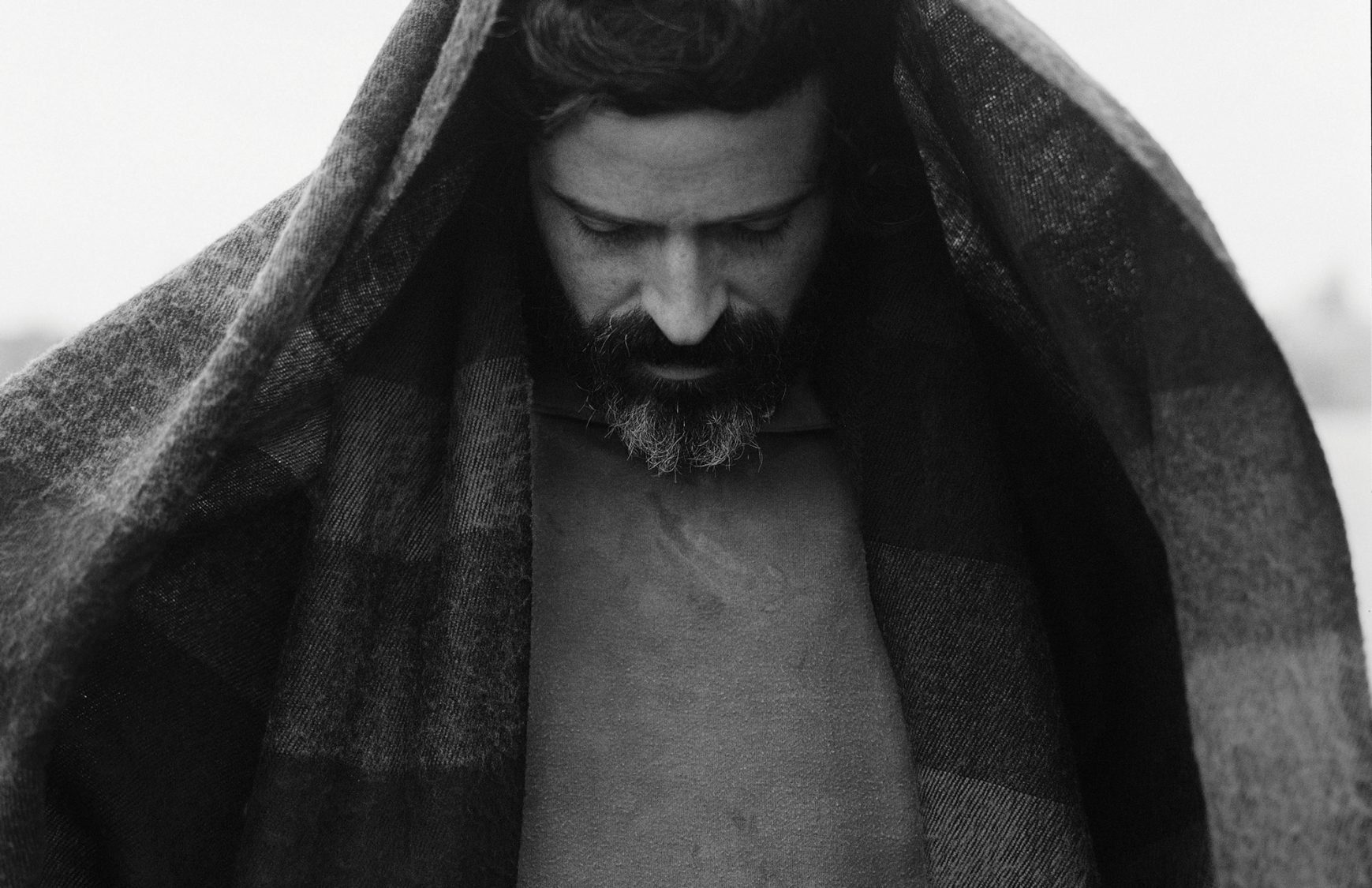“I feel like I’m wearing a mask made out of dead meat,” Devendra said, gesturing toward his face with outstretched fingers pulling down as if tugging at the mask with invisible strings. “Aren’t we all?” I asked. We were talking about the photoshoot Tricycle had arranged in New York, the previous stop on his tour, and I wondered if Devendra Banhart—musician, artist, poet, and Tibetan Buddhist practitioner—was echoing the sentiment of Milarepa’s famous line: “This thing we call a corpse, so fearful to behold, is already right here—our own body.” Devendra’s immediate laughter made me think he had just been describing the physical sensation of road weariness as he sat in the balcony of Washington, DC’s 9:30 Club, gazing down at the empty stage where he would perform the penultimate show of his North American tour. But I’m still not quite sure.
I confessed to Devendra that I had never done anything like this interview before. He shared some stories of the many (mostly terrible) interviews he has done over the years and pointed out that he had never really talked publicly about his Buddhist practice before. We agreed that our shared sense that neither of us had any idea what we were doing was an excellent starting point, and then Devendra kindly suggested that I start recording.
We had exchanged a few emails over the past year, mostly about Padmasambhava, the 8th-century tantric master known more frequently in Tibet as Guru Rinpoche or the Second Buddha. I had worked on an exhibition of art related to Guru Rinpoche for the Rubin Museum of Art in New York City and the Frances Young Tang Teaching Museum at Skidmore College, where I teach. Devendra had been acting in a film about Guru Rinpoche that was being made by his teacher, Neten Chokling Rinpoche. In one email, Devendra expressed his regret about not being able to travel to upstate New York to see the exhibition because of shooting schedules in Nepal and work on his latest album in LA. He described his careful study of every page of the Second Buddha exhibition catalog that I had sent him and promised to send me a copy of the album when it was done, noting that it was “totally influenced by Guru Rinpoche.” When a vinyl copy of Ma (Nonesuch Records, 2019) arrived months later, I started listening for traces of that influence, and I eventually asked Devendra if he might be willing to talk about it for a piece in Tricycle.

At the beginning of the interview, Devendra joked that what he had really wanted to do was put together a playlist of Buddhist songs (“I mean, Joni Mitchell has a song about meeting Trungpa!”) but that somehow we had ended up here instead. When I responded that I was hoping to discuss his new album in that respect, he thought for a moment and then asked if I had received the vinyl record, adding, “Did you open it?”
I had opened it. The album comes with two folded posters inside. One reproduces a painting of flowers by Devendra with the lyrics to the album’s thirteen tracks on the other side. The other has the six-syllable mantra of Avalokiteshvara on one side; on the other are the names of Tibetans who burned themselves alive to protest the brutal destruction of their culture. I described to Devendra the heartbreaking sorrow that I experienced when I unfolded the poster and recognized that I was holding a kind of self-immolation memorial in my hands. We discussed the impossibility of explaining or interpreting these acts of violent self-sacrifice and the necessity of bearing witness even, or especially, in the face of suffering we cannot comprehend.
Some of the technicians and crew at the club were moving around the stage, and as the high-decibel testing of the rock club’s sound system began, Devendra ushered me to a quiet room backstage. Devendra’s musical career has spanned over two decades, and the ten studio albums and numerous collaborations he has released chart a path of musical and lyrical experimentation hailed by critics and a circle of adoring fans and dismissed or derided by others. In our backstage conversation, the story of another journey unfolded—this one leading from the spiritual community of his childhood to the act of taking refuge with Neten Chokling Rinpoche.
For Devendra the desire to practice arose from a growing recognition of the link between fixation on the self and unhappiness.
Devendra received his first name from his parents’ guru, Maharaj-ji Prem Rawat, and he still considers Maharaj-ji to be his guru—the guru he was born with. At the age of 2, he moved with his mother (who is Venezuelan) from his birthplace of Houston, Texas, to Caracas, Venezuela, and lived there until his mother remarried when he was 14 and the family relocated to Los Angeles. Devendra became interested in Tibetan Buddhism in his twenties and has read books and listened to recorded teachings voraciously ever since then. However, a chance encounter with a thangka (scroll painting) of the Medicine Buddha in the Art Institute of Chicago stands out as the catalyst for his transformation. With an expression simultaneously conveying awestruck disbelief and experiential certainty, Devendra told me how the image had appeared to him as fully present and alive, radiating out from the canvas and sucking him into it at the same time. He feels that the painting imprinted something upon him in that moment, something around the periphery of his being that has slowly made its way to his very heart.
In the ten years following that encounter, Devendra became increasingly certain that he wanted to take refuge in the Tibetan Buddhist tradition. He discussed the decision with his parents in the same way he would have announced his intention to marry. He had grown up with one spiritual family and was now asking for their blessings as he chose a second family. We talked about the difficulty of even using the word “guru” in a society so averse to authority and hierarchy, and about the challenge of exposing and uprooting abuses of the role without destroying a vital component of Vajrayana. Devendra spoke of the pain experienced by victims of abuse by spiritual teachers and how that suffering is compounded when the very community to which they should be turning for protection and support is instead devoted to protecting and enabling the abuser. We spoke of our shared admiration for teachers working to combat these patterns, such as Lama Rod Owens, who had addressed the crowd from the stage at Devendra’s concert in Boston two nights earlier.
The visceral experience of the Medicine Buddha in Chicago was followed, and deepened, by a number of other moments of insight. Devendra described a bookshelf in his home in Los Angeles that was completely filled with dharma books from various traditions. Below those was a shelf filled with cookbooks, and as he was gazing at the shelf one day, he suddenly recognized that the instructions in the dharma books and the recipes in the cookbooks were the same. Thinking you could gain realization by reading a dharma book was akin to thinking you could enjoy a good meal by reading a cookbook: to actualize either would require real practice. For Devendra the desire to practice arose from what he described as “experiencing the utter futility of samsaric existence” and a growing recognition of the link between fixation on the self and unhappiness.
“I think for me, what it really comes down to is the realization that hell,” he paused for a moment, letting the full weight of the word fill the room, “hell is taking everything personally. And I know this is true because I used to take everything personally, and it was hell. And without the dharma, wow, I would still take everything personally and it would be hell.” Although he was unfailingly kind and generous during our time together, Devendra described himself as someone who “can barely stand other people.” He joked that perhaps he was drawn to Tibetan Buddhism because the superheroes of the tradition are hermits who live alone in secluded meditation. In Neten Chokling Rinpoche’s Guru Rinpoche film, Devendra plays a neuroscientist: “The character is basically an embodiment of ‘the West’—vain, self-obsessed, angry—so it was really easy for me.” In very practical terms, Devendra sees tonglen (the practice of taking in others’ suffering and sending out compassion) and recognizing all beings as one’s mother as the keys to his own liberation from the hell of taking everything personally. When he spoke about “mother recognition” in particular, he paused and looked up at the ceiling for a moment, then wiped a tear from his eye as he exhaled and said, “It’s powerful. I can’t even really talk about it without crying.”
Devendra sees recognizing all beings as one’s mother as key to his own liberation from the hell of taking everything personally.The songs on Ma reverberate with this sense of love and suffering as inextricably intertwined. From the wistful advice offered to an unborn child in “Is This Nice?” to the elegiac beauty of “Memorial,” the album echoes the heartbreak of bearing witness to the suffering of this world without turning away. I tried to get at some of this by telling Devendra that I am reminded of the bodhicitta aspiration—the vow to attain enlightenment for the benefit of all beings—in Shantideva’s Way of the Bodhisattva when I hear verses in his song “Ami”:
I had a dream last night
And now I wanna be a streetlight
I wanna be a streetlight
To guide your path at nightI saw you gently weep
And now I wanna be a lion
I wanna be a lion
Curled up at your feet
Something to rely on
I’ll be something to rely on
He shrugged off the comparison a bit, so I pressed further, asking him more directly about the tradition of using love songs as a way of expressing a relationship with the divine, like Kabir or the 6th Dalai Lama. As I spoke, Devendra twisted his face and drew his legs back, demonstrating his discomfort with the comparison. “Let’s not get carried away,” he finally interrupted. “I mean, I’m still trying to get laid with these songs.”

Devendra described life on tour as a sort of intensified experience of samsara: set up, sound check, perform, break down, back to the hotel at three in the morning. Then wake up, drive to the next city, and repeat, and repeat, and repeat. Everything that can go wrong, will. There are unexpected obstacles around every corner. I was reminded of Trungpa Rinpoche’s summary of the Vajrayana as wearing obstacles as adornments, and we spent a while appreciating the power of that particular phrase. Devendra described the experience of traveling across India and Nepal while working on the film and his constant amazement at Neten Chokling Rinpoche’s “effortless compassion” in every situation, contrasting it with the immense and only occasionally successful efforts he makes to mitigate the negative consequences of his own desires and aversions. For Devendra, witnessing the effortlessness of Neten Chokling Rinpoche’s compassion even in the most challenging circumstances gave a profound depth and stability to his practice of taking refuge. On tour, he wakes up an hour before the rest of the band in order to complete daily practices before an altar assembled in a different hotel room each night. “Now I don’t know how I could possibly tour without practice.”
The sounds of musicians tuning their instruments signaled the end of the interview, as Devendra had to join his band on stage for the sound check. I pushed the red button on my phone to stop the recording and thanked him for his time. A small circle on the phone started spinning to indicate the device’s progress in saving the interview. I made my way back to the balcony and kept glancing back as the little circle keep spinning and spinning while I watched the sound check. It was still spinning when the band made their way backstage again, and I mentioned to Devendra that I was worried the recording had vanished into the cloud. He laughed heartily and said, “Oh well, wouldn’t that be perfect: we made a digital sand mandala.” In fact, I had captured only the first nine minutes of our ninety-minute conversation. After an initial moment of despair, the entire lost interview flooded through my mind, and I laughed as I remembered myself talking about wearing obstacles as adornments. Then I started scribbling down notes as fast as I could.
Thank you for subscribing to Tricycle! As a nonprofit, we depend on readers like you to keep Buddhist teachings and practices widely available.
